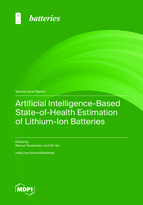Artificial Intelligence-Based State-of-Health Estimation of Lithium-Ion Batteries
A special issue of Batteries (ISSN 2313-0105). This special issue belongs to the section "Battery Performance, Ageing, Reliability and Safety".
Deadline for manuscript submissions: closed (20 April 2023) | Viewed by 47392
Special Issue Editors
Interests: electric vehicles; lithium-ion batteries; smart battery management renewable energy; energy storage; wind power; static synchronous compens.
Special Issues, Collections and Topics in MDPI journals
Interests: state of health estimation; lifetime extension; feature engineering; machine learning.
Special Issues, Collections and Topics in MDPI journals
Special Issue Information
Dear Colleagues,
Lithium-ion batteries have a wide range of applications, but one of their biggest problems is their limited lifetime due to performance degradation during usage. It is, therefore, essential to determine the battery’s state of health (SOH) so that the battery management system can control the battery, enabling it to run in the best state, and thus prolong its lifetime. Artificial Intelligence (AI) technologies possess immense potential in inferring battery SOH, and can extract aging information (i.e., SOH features) from measurements and relate them to battery performance parameters, avoiding a complex battery modeling process. Therefore, this Special Issue aims to showcase manuscripts showing efficient SOH estimation methods using AI which exhibit good performance such as high accuracy, high robustness against the changes in working condition, and good generalization, etc.
Potential topics include but are not limited to:
- Effective data mining of features for AI methods;
- Network structures (study of different AI technologies);
- Learning strategies (supervised, unsupervised, reinforcement learning);
- Transferring AI-based models in between different battery technologies and applications;
- Sequentially updated models (probabilistic methods, self-learning, etc.);
- Physics-informed AI method for battery SOH estimation;
- Digital twins for battery cells or system;
- Hardware implementation of AI methods.
Prof. Dr. Remus Teodorescu
Dr. Xin Sui
Guest Editors
Manuscript Submission Information
Manuscripts should be submitted online at www.mdpi.com by registering and logging in to this website. Once you are registered, click here to go to the submission form. Manuscripts can be submitted until the deadline. All submissions that pass pre-check are peer-reviewed. Accepted papers will be published continuously in the journal (as soon as accepted) and will be listed together on the special issue website. Research articles, review articles as well as short communications are invited. For planned papers, a title and short abstract (about 100 words) can be sent to the Editorial Office for announcement on this website.
Submitted manuscripts should not have been published previously, nor be under consideration for publication elsewhere (except conference proceedings papers). All manuscripts are thoroughly refereed through a single-blind peer-review process. A guide for authors and other relevant information for submission of manuscripts is available on the Instructions for Authors page. Batteries is an international peer-reviewed open access monthly journal published by MDPI.
Please visit the Instructions for Authors page before submitting a manuscript. The Article Processing Charge (APC) for publication in this open access journal is 2700 CHF (Swiss Francs). Submitted papers should be well formatted and use good English. Authors may use MDPI's English editing service prior to publication or during author revisions.
Keywords
- lithium-ion battery
- SOH estimation
- artificial intelligence
- lifetime prediction
- physics-informed AI
- neural networks
- supervised learning
- unsupervised learning
- self-learning
- data mining







